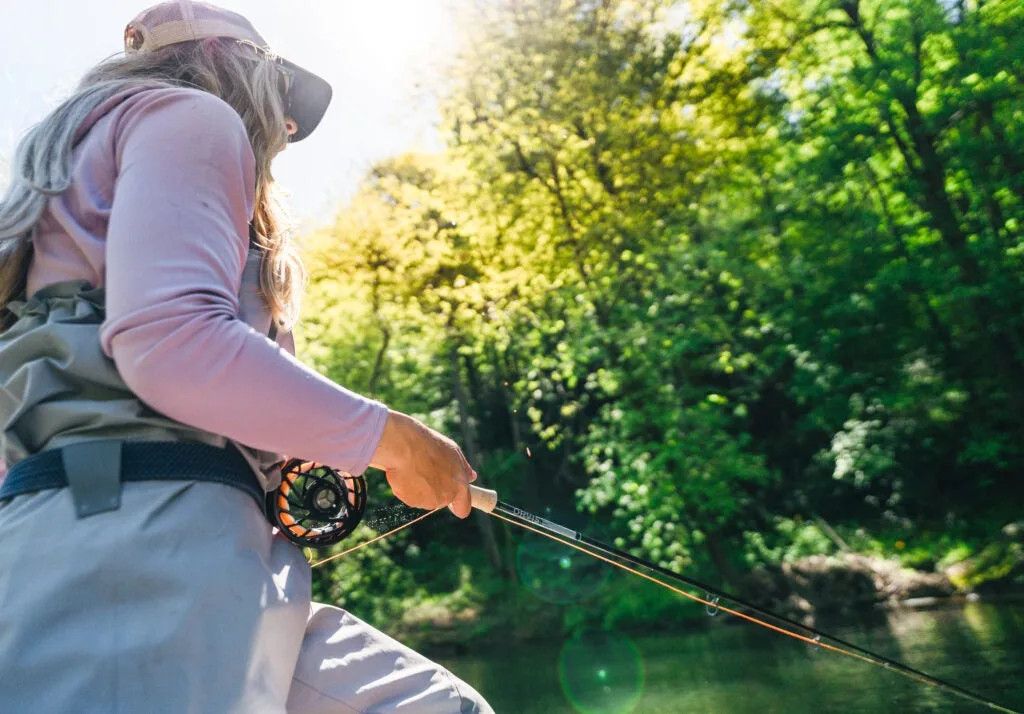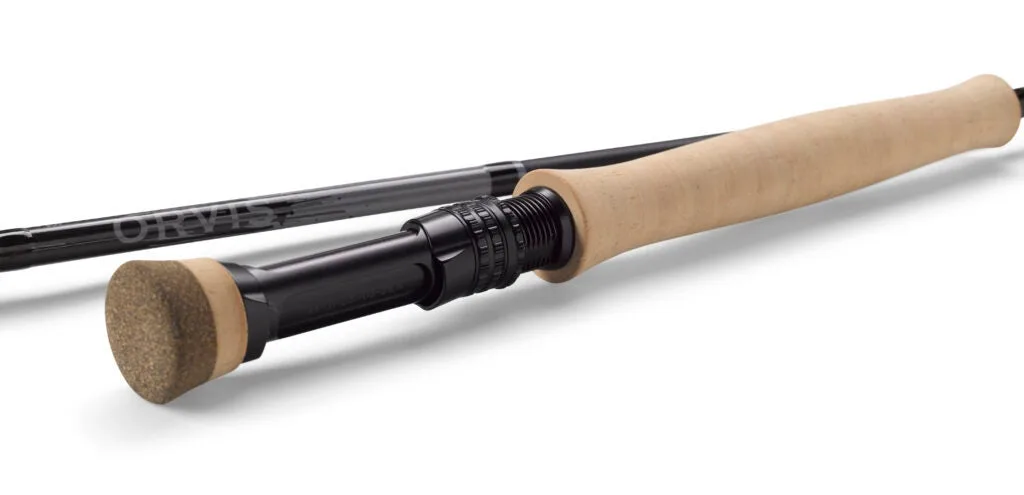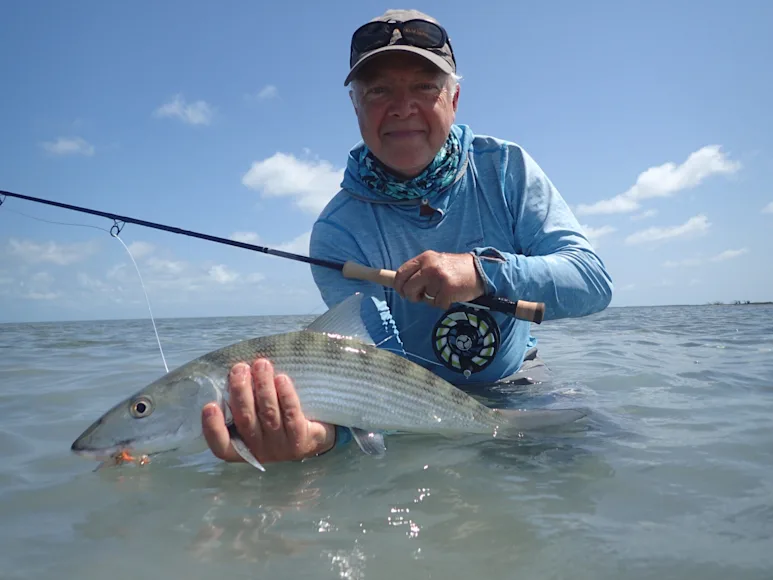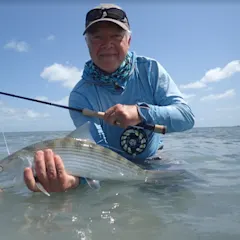_We may earn revenue from the products available on this page and participate in affiliate programs. Learn more ›
_
You can’t say we didn’t come well-armed: In our flats skiff in the Bahamas, my buddy and I had five fly fishing rods
. The rods came from three different manufacturers, in sizes designed to handle any fish from young bonefish to 120-pound tarpon
. They were all top-of-the-line sticks, and most had been proven in battle, except for a just-out-of-the-box, never-before-fished, 8-weight Orvis Helios 3 Blackout
. It’s a brand-new fly rod from a brand-new line of Orvis fly rods.
The Next Generation of Orvis Helios Fly Rods
Since the introduction of the Orvis Helios 3D
in 2017, they’ve helped put a serious new luster on the Orvis brand of fishing gear. Orvis designed the Helios 3D for distance casting, while the Helios 3F rod marries that signature backbone to a slightly softer tip for an edge in accuracy. The Blackout series
takes that technology in an even more refined direction: rods produced for specific—and specifically challenging—casting situations and environments.
On the bow of our flats skiff, with tailing bonefish and permit in our sights, even I asked myself: How much of the Blackout’s breathless product prose was hype?
Over two days of serious fishing, rarely was the Blackout fly rod stowed. Even with very good other choices literally at hand, time and again we reached for the new kid in town. We tried to put our finger on it. The Blackout 8-weight is a fast-action rod that seems not to rely on speed so much—although it has plenty of that. Instead, it relies on a kind of casting authority that helped fill the gap between the casts we knew we had to make, and the casts that we actually made in the moment.
Several times I laid out the line and thought: Dang. Did I really just do that?

Orvis designed its new line of Blackout rods for specialized fishing scenarios. Orvis
Fly Rod Models in the Orvis Helios 3 Blackout Series
Instead of launching a traditional rod series with models across most rod weights, the Orvis Helios 3 Blackout
comes in three different models. There is a 3-weight 11-footer; a 9 1/2-foot 5-weight; and the 8 1/2-foot 8-weight. We’ll get to the specifics of each in a moment, but here’s the lowdown on their shared DNA.
All three Blackout rods use the existing Helios 3 materials package, but Orvis
built them with specialized tapers. The stripping guides are SiC/titanium, for a super-hard finish and minimum friction on the cast and during the fight. Reel seats are Type III anodized aluminum. All the components other than the grip have a non-glare, black-on-black layup: black reel seat frame with a black carbon insert, non-glare blanks, and black guides.
For this series, Orvis eschews the signature white band and the overly large Orvis logo in front of the grip. People either loved or hated that white banner—with most in the latter category. (Note: For certain newer models in the Helios 3 family, you can order the rods with blue or green bands.) People will either love or hate the “tactical” look of the Blackout, especially the drippy, melted-look logo. But at least it’s a subdued gray color. Personally, as long as the rod doesn’t have fuzzy dice painted on the blank, I’m more interested in performance than looks.
3-Weight Orvis Helios 3 Blackout
The most specialized of the rod is the 11-foot-long 3-weight. Designed to tap into the trend of European nymphing, the rod telegraphs the most nuanced takes and keep the angler in touch with a weighted nymph’s ride along the river bottom. The extra length helps deal with confused current seams when you’re fishing at a distance. But given that the Blackout 3-weight is built with the same famously light layups as the Orvis Helios 3 line, that extra length should be barely noticeable in swing weight. A long rod for long days on the water.
5-Weight Orvis Helios 3 Blackout
The all-around performance of a traditional 5-weight fishing rod gets a 6-inch boost in length in the Blackout series. That half-foot could pay dividends. Trout anglers will appreciate the longer rod’s ability to mend line over conflicting currents in the river or creek, and it’s a blessing when trying more advanced casts like a reach cast or steeple. The Orvis Helios backbone helps punch complicated rigs, such as weighted nymphs and hopper-dropper combos, without tailing leaders and aggravating snarls.
8-Weight Orvis Helios 3 Blackout
Orvis takes a different tack with its 8-weight Blackout. They shaved 6 inches off the traditional 9-foot length. On the Bahamas flats, I fretted at first about the potential loss of some leverage when I needed to pull 30 feet of fly line off the water for a second shot at bonefish. And I wondered about the shorter length as I waded the surf zone and tried to punch a fly through 20 miles-per-hour winds. But the rod’s spine held up to the challenge.
I can’t say I have the skill set to power a 60-foot cast in those conditions. But I had no doubt that the Blackout put extra distance and tighter loops into my delivery. And the slightly shorter length helped me get false casts off in a hurry without sacrificing the ability to shoot line.
I fish for false albacore at Cape Lookout, North Carolina. These waters are known as the place “where 8-weights go to die.” The Blackout 8-weight fights like a 9-weight. If it rips an intermediate fly line out of the chop the way I think it will, it might turn that old adage on its head.

The Orvis Helios 3 Blackout Orvis
Think of the Orvis Blackout Series as Surgical Fishing Tools
Orvis calls the Blackout rods
specialized tools for “scenario-specific” applications. That’s some fancy marketing lingo. But I think these rods have a bit broader application than what that label might infer, especially in the 5- and 8-weight models.
The 5-weight Orvis Helios 3 Blackout is pitched as a “boat rod” particularly suitable for use on drift boats, rafts, and pontoons. But its speed and longer length would be awesome when stalking big pond bluegills. In that scenario, you need a rod that can punch a deer-hair popper
through the breeze or lift your backcast over brushy shrubs. Ditto for anyone fishing a float tube or small pontoon.
The 8-weight rod might boast of saltwater-proof materials, but it’d be a beast on pike rivers
and lakes and river-running stripers. Bottom line: The way these rods handle their “scenario-specific” tasks has plenty of utility when you want to use a Blackout to beat on carp or bigmouths.
Is an Orvis Blackout Fly Rod Worth the Money?
High-end fly rods are expensive, and the Blackouts are no exception. The rods retail for $998. Understand what they are designed to do. If you’re a novice fly caster, these rods will not take you to a higher level of proficiency. In fact, beginner anglers might struggle with the inherent speed of the Blackout series. And that seriously long 3-weight, in particular, is not for the newbie.
But experienced fly anglers have a lot to gain from the technology of these rods and their rule-bending design specs. If you’re the sort who will invest serious cash in fishing equipment that will excel at the upper end and in the margins of what is possible—without sacrificing too much middle ground—the Blackout should be high on your list. (Although you might want to keep that list hidden from your significant other.) These are rods for anglers who take their passion very seriously.
I left the Bahamas flats sold on the Orvis Helios 3 Blackout 8-weight. It does a stellar job at what it is designed to do: Enable a caster to pick up line and change directions quickly while chasing fast-moving fish. But the rod turned into our go-to choice for just about every casting situation.






